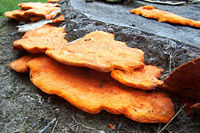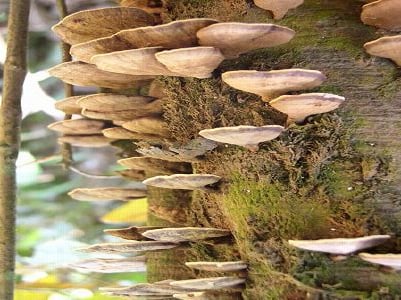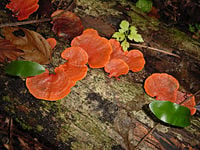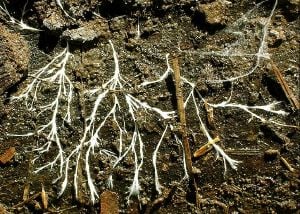Difference between revisions of "Fungus" - New World Encyclopedia
m (→Role in Nature) |
|||
| Line 19: | Line 19: | ||
==Structure== | ==Structure== | ||
| − | + | Fungi may be single-celled or multicellular. Multicellular fungi are composed of networks of long hollow tubes called hyphae. The hyphae often aggregate in a dense network known as mycelium. The mycelium grows through the medium on which the fungus feeds. Because fungi are embedded in the medium in which they grow, most often soil, they are often not visible to the naked eye. | |
| − | |||
| − | |||
| − | Fungi may be single-celled or multicellular. Multicellular fungi are composed of networks of long hollow tubes called hyphae. The hyphae often aggregate in a dense network known as mycelium. The mycelium grows through the medium on which the fungus feeds. Because fungi are embedded in the medium in which they grow, they are often not visible to the naked eye. | ||
Although fungi lack true organs, the mycelia may become organized into more complex reproductive structures called fruiting bodies, or sporocarps, when conditions are right. "Mushroom" is the common name given to the above-ground fruiting bodies of many fungal species. Although these above-ground structures are the most conspicuous to humans, they make up only a small portion of the entire fungal body. Some fungi form rhizoids, which are underground root-like structures that provide support and transport nutrients from the soil to the rest of the mycelium. | Although fungi lack true organs, the mycelia may become organized into more complex reproductive structures called fruiting bodies, or sporocarps, when conditions are right. "Mushroom" is the common name given to the above-ground fruiting bodies of many fungal species. Although these above-ground structures are the most conspicuous to humans, they make up only a small portion of the entire fungal body. Some fungi form rhizoids, which are underground root-like structures that provide support and transport nutrients from the soil to the rest of the mycelium. | ||
| − | |||
| − | |||
The largest organism in the world is purported to be a single ''Armillaria ostoyae'' individual growing in a forest in eastern Oregon. The underground mycelial network may cover as much as 2200 acres). | The largest organism in the world is purported to be a single ''Armillaria ostoyae'' individual growing in a forest in eastern Oregon. The underground mycelial network may cover as much as 2200 acres). | ||
| + | [[Image:Hyphae.JPG|thumb|left|Hyphae as seen under a log]] | ||
[[Image:Fungi Belize.jpg|right|thumb|200px|Fungus growing on fallen tree trunks in [[Belize]].]] | [[Image:Fungi Belize.jpg|right|thumb|200px|Fungus growing on fallen tree trunks in [[Belize]].]] | ||
| Line 40: | Line 36: | ||
==Fungi and Humans== | ==Fungi and Humans== | ||
| − | + | Besides their tremendous indirect importance to humans because of their role in the life cycles of plants, fungi also affect us directly in many ways. | |
| − | |||
| − | + | ===Mushrooms=== | |
| + | ===Truffles=== | ||
| + | Truffles are the underground fruiting bodies of several types of fungi which have a | ||
| + | ===Yeast=== | ||
| + | ===Penicillin=== | ||
| + | ===Fungal Diseases=== | ||
| − | + | Mushrooms, truffles, and yeast are fungi used for food. [[Penicillin]] and other antibiotics have been derived from the natural defenses of molds and other fungi against bacteria. Fungi are also being used as biological defenses against insects, and other fungi. | |
| − | |||
| − | + | Fungi can also be harmful to human interests. They are one of the main causes of spoiling food as well as clothing, wood, paper, and other organic materials. Some types can cause human diseases, athletes foot being the most common but others much more serious. Others cause diseases in animals and plants. Dutch elm disease, caused by a fungus introduced from Europe, killed off almost all of the native elm trees in North America. | |
| − | + | ==Types of fungi== | |
| − | |||
| − | |||
| − | |||
| − | |||
| − | + | The major divisions ([[phyla]]) of fungi are mainly classified based on their sexual reproductive structures. Currently, five divisions are recognized: | |
| + | [[Image:K_1033CR08-9_Yellow_fungus_on_stalk.jpg|right|thumb|200px|Yellow fungus]] | ||
| + | * The Chytridiomycota are commonly known as chytrids. These fungi produce zoospores that are capable of moving on their own by simple flagella. | ||
| + | * The Zygomycota are known as zygomycetes and reproduce sexually. Black bread mold (''Rhizopus stolonifer'') is a common species that belongs to this group, another is ''Pilobolus'', which shoots specialized structures through the air for several meters. | ||
| + | * Members of the Glomeromycota are also known as the arbuscular mycorrhizal fungi. Only one species has been observed forming zygospores; all other species only reproduce asexually. | ||
| + | * The Ascomycota, commonly known as sac fungi or ascomycetes, form meiotic spores called ascospores, which are enclosed in a special sac-like structure called an ascus. This division includes morels, some mushrooms and truffles, as well as single-celled yeasts and many species that have only been observed undergoing asexual reproduction. | ||
| + | * Members of the Basidiomycota, commonly known as the club fungi or basidiomycetes, produce meiospores called basidiospores on club-like stalks called basidia. Most common mushrooms belong to this group, as well as rust and smut fungi, which are major pathogens of grains. | ||
| + | Although the water molds and slime molds have traditionally been placed in kingdom Fungi and are still studied by mycologists, they are not true fungi. Unlike true fungi, the water molds and slime molds do not have cell walls made of chitin. In the 5-kingdom system, they are currently placed in kingdom Protista. | ||
| − | + | ==Reproduction== | |
| − | |||
| − | + | Fungi may reproduce sexually or asexually. In asexual reproduction, the offspring are genetically identical to the “parent” organism (they are [[cloning|clones]]). During sexual reproduction, a mixing of genetic material occurs so that the offspring exhibit traits of both parents. Many species can use both strategies at different times, while others are apparently strictly sexual or strictly asexual. Sexual reproduction has not been observed in some fungi of the Glomeromycota and Ascomycota. These are commonly referred to as Fungi imperfecti or Deuteromycota. | |
| − | + | Yeasts and other unicellular fungi can reproduce simply by budding, or “pinching off” a new cell. Many multicellular species produce a variety of different asexual spores that are easily dispersed and resistant to harsh environmental conditions. When the conditions are right, these spores will germinate and colonize new habitats. | |
| − | + | ==References== | |
| − | |||
| − | |||
| − | |||
| − | |||
| − | |||
| − | == | ||
| − | |||
| − | |||
| − | |||
| − | |||
| − | |||
| − | |||
| − | |||
| − | |||
| − | |||
| − | |||
| − | |||
| − | |||
* {{cite web | * {{cite web | ||
| url = http://www.healthatoz.com/healthatoz/Atoz/ency/mushroom_poisoning.jsp | | url = http://www.healthatoz.com/healthatoz/Atoz/ency/mushroom_poisoning.jsp | ||
Revision as of 05:57, 3 June 2006
| Fungi | ||||
|---|---|---|---|---|
 Orange saprotrophic fungus. | ||||
| Scientific classification | ||||
| ||||
| Divisions | ||||
|
Chytridiomycota |

The fungi (singular fungus) make up one of the kingdoms into which living things are divided by biologists. They differ from bacteria in having a cell nucleus; from plants in not making their own food through photosynthesis; and from animals in not being mobile and in absorbing nutrition externally rather than internally. Fungi include mushrooms, yeasts, moulds, mildews, and others. Athough often un-noticed or misunderstood by humans fungi play a vital role in the earth's ecosystems.
Structure
Fungi may be single-celled or multicellular. Multicellular fungi are composed of networks of long hollow tubes called hyphae. The hyphae often aggregate in a dense network known as mycelium. The mycelium grows through the medium on which the fungus feeds. Because fungi are embedded in the medium in which they grow, most often soil, they are often not visible to the naked eye.
Although fungi lack true organs, the mycelia may become organized into more complex reproductive structures called fruiting bodies, or sporocarps, when conditions are right. "Mushroom" is the common name given to the above-ground fruiting bodies of many fungal species. Although these above-ground structures are the most conspicuous to humans, they make up only a small portion of the entire fungal body. Some fungi form rhizoids, which are underground root-like structures that provide support and transport nutrients from the soil to the rest of the mycelium.
The largest organism in the world is purported to be a single Armillaria ostoyae individual growing in a forest in eastern Oregon. The underground mycelial network may cover as much as 2200 acres).

Role in Nature
Most fungi live by decomposing the remains of dead plants and animals. This releases carbon and other materials back to the environment where they can be reused by plants. Other fungi are parasites, living in or on the bodies of plants and animals and sometimes causing diseases. Others live in symbiotic mutually beneficial relationships with other organisms. Lichens are a combination of an algae, which provides food through photosynthesis, and a fungus, which provides protection to the algae. Leaf-cutter ants and some species of termites live in a symbiotic relationship with fungi in which the insects protect the fungi and provide them with plant material to decompose while the fungi provide food for the insects.
The most important symbiotic relationship in which fungi take part was unknown until the last part of the Twentieth Century. That is mycorrhizas, the relationship between fungi and plants. Specialized fungi live on the roots of most (perhaps 95 percent of all) land plants. The hyphae of the fungi extend out into the soil and form a network of fibers which in effect extend the root system of the plant enabling it to more effectively absorb water and minerals. The plant provides the fungi with nutrients produced by its photosynthesis. Most plants could not thrive without a partnership with these fungi.
Fungi and Humans
Besides their tremendous indirect importance to humans because of their role in the life cycles of plants, fungi also affect us directly in many ways.
Mushrooms
Truffles
Truffles are the underground fruiting bodies of several types of fungi which have a
Yeast
Penicillin
Fungal Diseases
Mushrooms, truffles, and yeast are fungi used for food. Penicillin and other antibiotics have been derived from the natural defenses of molds and other fungi against bacteria. Fungi are also being used as biological defenses against insects, and other fungi.
Fungi can also be harmful to human interests. They are one of the main causes of spoiling food as well as clothing, wood, paper, and other organic materials. Some types can cause human diseases, athletes foot being the most common but others much more serious. Others cause diseases in animals and plants. Dutch elm disease, caused by a fungus introduced from Europe, killed off almost all of the native elm trees in North America.
Types of fungi
The major divisions (phyla) of fungi are mainly classified based on their sexual reproductive structures. Currently, five divisions are recognized:
- The Chytridiomycota are commonly known as chytrids. These fungi produce zoospores that are capable of moving on their own by simple flagella.
- The Zygomycota are known as zygomycetes and reproduce sexually. Black bread mold (Rhizopus stolonifer) is a common species that belongs to this group, another is Pilobolus, which shoots specialized structures through the air for several meters.
- Members of the Glomeromycota are also known as the arbuscular mycorrhizal fungi. Only one species has been observed forming zygospores; all other species only reproduce asexually.
- The Ascomycota, commonly known as sac fungi or ascomycetes, form meiotic spores called ascospores, which are enclosed in a special sac-like structure called an ascus. This division includes morels, some mushrooms and truffles, as well as single-celled yeasts and many species that have only been observed undergoing asexual reproduction.
- Members of the Basidiomycota, commonly known as the club fungi or basidiomycetes, produce meiospores called basidiospores on club-like stalks called basidia. Most common mushrooms belong to this group, as well as rust and smut fungi, which are major pathogens of grains.
Although the water molds and slime molds have traditionally been placed in kingdom Fungi and are still studied by mycologists, they are not true fungi. Unlike true fungi, the water molds and slime molds do not have cell walls made of chitin. In the 5-kingdom system, they are currently placed in kingdom Protista.
Reproduction
Fungi may reproduce sexually or asexually. In asexual reproduction, the offspring are genetically identical to the “parent” organism (they are clones). During sexual reproduction, a mixing of genetic material occurs so that the offspring exhibit traits of both parents. Many species can use both strategies at different times, while others are apparently strictly sexual or strictly asexual. Sexual reproduction has not been observed in some fungi of the Glomeromycota and Ascomycota. These are commonly referred to as Fungi imperfecti or Deuteromycota.
Yeasts and other unicellular fungi can reproduce simply by budding, or “pinching off” a new cell. Many multicellular species produce a variety of different asexual spores that are easily dispersed and resistant to harsh environmental conditions. When the conditions are right, these spores will germinate and colonize new habitats.
ReferencesISBN links support NWE through referral fees
- Kaminstein, D. (2002). Mushroom poisoning. Retrieved 2006-01-05.
External links
- Fungi pictures on Biocrawler.com
- Sulphur Shelf Fungus Laetiporous sulphureous photos and information
- Giant Puffball Fungus Calvatia gigantea photos and information
- British Mycological Society
- The Fifth Kingdom
- Mycological Society of America
- MykoWeb
- Fungi Perfecti, Gourmet and medicinal fungi
- North American Mycological Society
- Sydney Fungal Studies Group
- Australian FungiMap Project
- Northwest Fungi, Online Journal
- Pacific Northwest Fungi Database
Credits
New World Encyclopedia writers and editors rewrote and completed the Wikipedia article in accordance with New World Encyclopedia standards. This article abides by terms of the Creative Commons CC-by-sa 3.0 License (CC-by-sa), which may be used and disseminated with proper attribution. Credit is due under the terms of this license that can reference both the New World Encyclopedia contributors and the selfless volunteer contributors of the Wikimedia Foundation. To cite this article click here for a list of acceptable citing formats.The history of earlier contributions by wikipedians is accessible to researchers here:
The history of this article since it was imported to New World Encyclopedia:
Note: Some restrictions may apply to use of individual images which are separately licensed.
